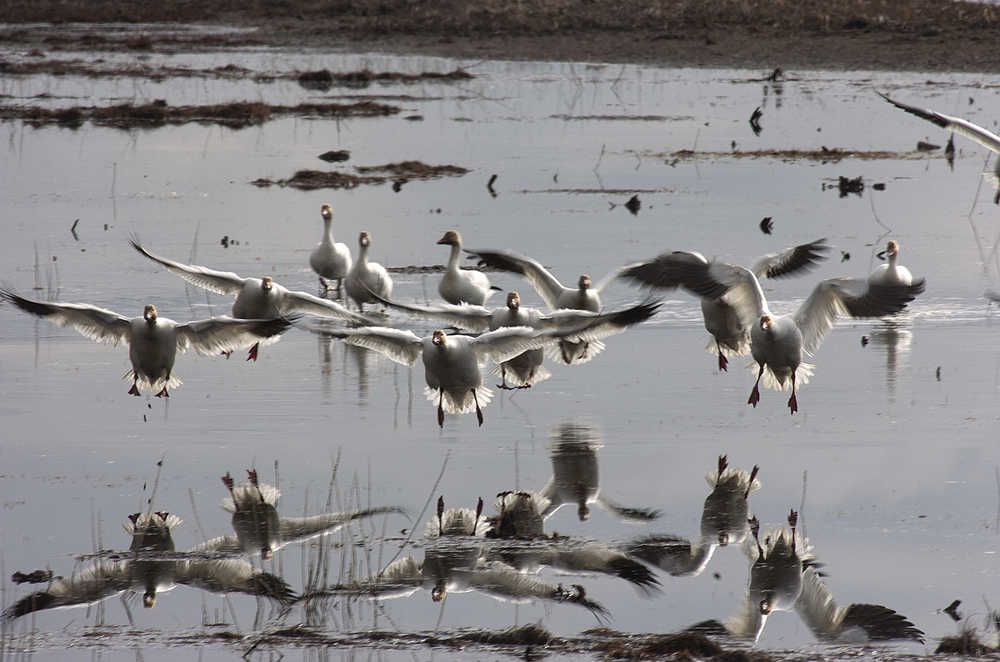Editor’s note: This story has been changed to correctly identify the agency critical of the road as the federal, rather than the state, Fish and Wildlife Service.
The U.S Fish and Wildlife service has criticized the City of Kenai’s proposal for a road in a wetland near the Kenai River.
In a letter to the Army Corps of Engineers, Fish and Wildlife Southeast Alaska Coordinator Steve Brockmann said his agency had concerns about the access road Kenai is seeking to build in the wetlands near the southern mouth of the Kenai River. Brockmann wrote that the proposed road “would encroach directly upon a very rich, ecologically sensitive, wetland area which hosts spring and fall migrations of geese, ducks, and many species of shorebirds.”
Kenai intends to construct a 1,500 foot gravel road from Bowpicker Lane through the city-owned wetland to the beach. According to Kenai’s Army Corps permit application, the road is primarily meant to provide access for summer dipnetters to fishing areas on the south bank of the Kenai River mouth.
According to the application, the most commonly used current access point is Dunes Road approximately 2 miles to the south. That route requires users to drive north along the beach through private property. Property owners have said that this traffic has brought loud music, litter, campfires, and vandalism.
The city applied for the Army Corps permit, required for construction through wetlands, in February 2015. Since then the permit application has been open for comment from federal and state agencies.
Brockmann said that the affected area “is very important habitat, primarily for spring migrating waterfowl and shorebirds, though it’s used during fall migration as well and throughout the year by other species.”
In his letter to the Army Corps, Brockmann wrote that five species of geese, seven species of duck, and twenty species of shorebird use the area during their migrations, and that six species of duck and seven species of shorebirds use it as a breeding ground.
The wetland is also classified as a possible coho salmon habitat, based on a 2007 study by Kenai Watershed Forum researcher Mike Gracz, who used data from the Alaska Department of Fish and Game’s Anadromous Waters Catalog to identify areas likely to be used as coho breeding grounds. Gracz said he did not know if any coho had been recorded in the area.
Brockmann said that the proposed road, which he expected to bring all-terrain vehicle, car, and pedestrian traffic, as well as loose dogs, would decrease the area’s value as a migratory staging area for birds.
The bed of the road would cover 1.35 acres and contain 5.600 cubic yards of gravel. Brockmann said it could lead to a long-term change in the wetland’s hydrology by creating a barrier to surface water flow.
Brockmann said that Kenai’s current proposal would also damage the dunes lying between the beach and inland areas, which serve as a buffer against storm-waves, saltwater, flooding, and tidal erosion. The road plans call for a parking lot and access fee stations to be built between the beach and the wetlands.
A 2008 Kenai ordinance identified the dune system on the north shore of the Kenai River mouth as “environmentally sensitive” and “vital to the beach ecosystem,” and required the city to protect the dunes with fences, “no trespassing” signs, and ticketing. Brockmann said that the south beach dune system is also vital.
“We think there are much less damaging places to put [the parking and fee stations],” Brockmann said. He said the road’s path could be altered so that the fee stations and parking area could be placed outside the wetland on the already-existing Royal Street.
Kenai’s Army Corps permit application included two alternative routes for the road. One traverses the wetland to the north of the city’s favored route, which the permit identifies as more environmentally damaging. Another, bordering the wetland and a developed area, is identified as impractical because of Kenai’s unsuccessful attempts to negotiate access from the private owners of the land it would cover.
Brockmann said Fish and Wildlife recommended other alternatives not described in the permit application.
“There are some other roads in the subdivision to the south that could be developed as access to the beach and minimize conflicts with local land owners,” Brockmann said. “To bisect the wetlands with a new road — we think it creates a lot of impacts that aren’t there now. That’s the primary basis of our objection.”
The Army Corps permit application also includes a proposal from Kenai to compensate for the lost wetland area by creating a permanent conservation easement on an area near Sea Catch Drive.
Brockmann’s letter said the proposed easement would have less value as bird habitat than the lost area because of a recently constructed helipad in the nearby Kenai Landing property. He recommended as an alternative easement a pond near the Port of Kenai Boat Launch Road.
Kenai city manager Rick Koch said that he had not yet read the letter from Brockmann, and could not address the concerns.
Reach Ben Boettger at ben.boettger@peninsulaclarion.com

